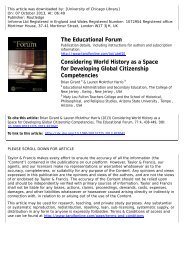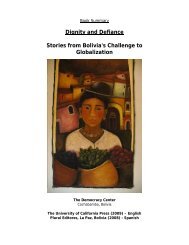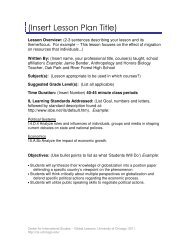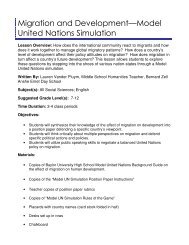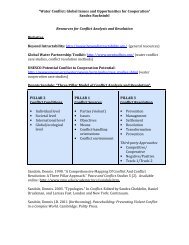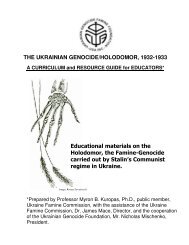Theories of Migration and Migrant Classifications Around the World
Theories of Migration and Migrant Classifications Around the World
Theories of Migration and Migrant Classifications Around the World
Create successful ePaper yourself
Turn your PDF publications into a flip-book with our unique Google optimized e-Paper software.
Optional Background Information for Teacher: All <strong>of</strong> <strong>the</strong> following videolectures were originally presented at <strong>the</strong> University <strong>of</strong> Chicago 2011 University <strong>of</strong>Chicago Summer Teacher Institute, “<strong>Migration</strong>: Causes <strong>and</strong> Consequences.” Allvideos can be found at this link:http://cis.uchicago.edu/summerinstitute/2011/resources/• "Economic Effects <strong>of</strong> Immigration: Lessons from <strong>the</strong> Chicago LaborMarket,” presented by Virginia Parks, Ph.D., School <strong>of</strong> Social ServiceAdministration, University <strong>of</strong> Chicago.• "International <strong>Migration</strong>: Trends, Issues, <strong>and</strong> Future Prospects," presentedby Aaron Terrazas, Policy Analyst, <strong>Migration</strong> Policy Institute.• "Organizations, Scenes, <strong>and</strong> Local Contexts,” presented by Terry NicholsClark, Pr<strong>of</strong>essor, Department <strong>of</strong> Sociology, University <strong>of</strong> Chicago.• "Seeking Sanctuary: Asylum <strong>and</strong> <strong>the</strong> Politics <strong>of</strong> Compassion in Irel<strong>and</strong>,”presented by Anwen Tormey Dept. <strong>of</strong> Anthropology, University <strong>of</strong> Chicago.Activities <strong>and</strong> Procedures:1. If students are not familiar with <strong>the</strong> basic “Push/Pull Factor” explanation <strong>of</strong> <strong>the</strong>migratory process, briefly explain this <strong>the</strong>ory <strong>and</strong> ask students to think about differentsituations in which this might be true. **For details, see step 5 in <strong>the</strong> “<strong>Migration</strong> 101”K-12 lesson at http://cis.uchicago.edu/summerinstitute/2011/resources/**• Push/Pull Factors: “Push” factors are things that drive people AWAY from aplace, while “Pull” factors are things that DRAW people IN to a place.2. (Pass out copies <strong>of</strong> “<strong>Theories</strong> <strong>of</strong> <strong>Migration</strong>” student worksheet. They will be takingnotes on <strong>the</strong> PowerPoint presentation on <strong>the</strong> brainmap.) For students who havealready discussed <strong>the</strong> “Push/Pull” process, simply review <strong>the</strong> definition <strong>and</strong> someexamples, which can be found on slide one <strong>of</strong> this lesson’s accompanying <strong>the</strong>PowerPoint presentation titled, “<strong>Migrant</strong> <strong>Classifications</strong>.”3. Ask students to think about whe<strong>the</strong>r <strong>the</strong> traditional “Push/Pull” model could possiblyhave any shortcomings. To prompt students, consider <strong>the</strong> following questions:• What does this definition tell you about <strong>the</strong> motivations <strong>of</strong> migrants? What doesit NOT tell you?o These are humans we are talking about—does this definition tell youanything about thoughts or feelings?• Are people always going to fall into just one <strong>of</strong> <strong>the</strong>se categories? Or could it beboth push <strong>and</strong> pull at <strong>the</strong> same time?Center for International Studies -- Global Lessons, University <strong>of</strong> Chicago, 2011.http://cis.uchicago.edu/



